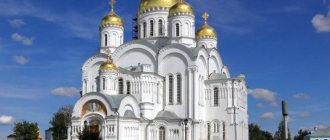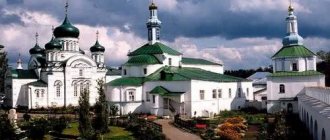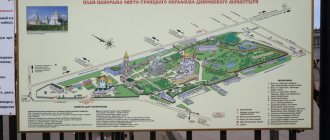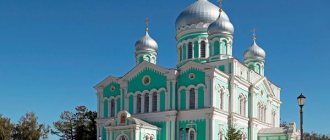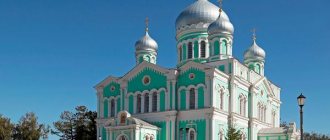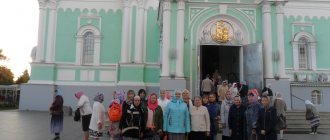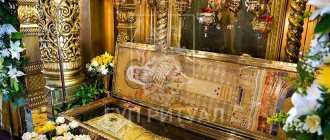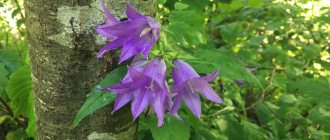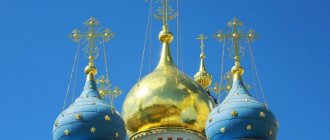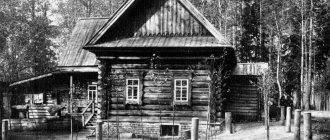In the southwest of Russia there is a glorious place about which legends have long been circulating. This land is Diveevo, a monastery full of miracles and healing effects on those who come for help. These places have been known since pre-war times. Russian Orthodox believers go to Diveevo, the springs provide that very life-giving force, and their fame spreads further and further. Even abroad they know about Diveevo and the miraculous springs located here. Tourists from Germany, Latvia, France, Israel, Orthodox believers from many parts of the planet come here.
The miraculous properties of holy water
To calm the soul, to heal illnesses, and to cleanse themselves of filth, those who suffer resort to the help of holy water. The physical, chemical and biological properties of the simplest and most inexplicable compound of hydrogen and oxygen on earth have not yet been fully studied. Meanwhile, the experience of generations confidently speaks in favor of holy water, which will help in incredible ways in any life circumstances.
An adult entrusts his problems to water if he believes in its power. Even non-believers unknowingly resort to the help of ordinary water, washing away the troubles of the day in the shower. Water relaxes and refreshes, and is often the first remedy for relieving fatigue and drowsiness. Scientists have proven that holy water has a special structure of molecules, their action is aimed at well-being and health promotion, normalization of a person’s emotional and spiritual background, and harmonization of the space around him. Perhaps even before such discoveries, people knew the effect of holy water, but they did not require explanation.
Many people add holy water to the bathtub for bathing babies so that children sleep soundly and more peacefully, and the “strongest” water also helps little children against the evil eye. Holy water is known as a remedy for healing spiritual and physical illnesses; believers often drink a few sips from the silver vats in which the water is stored in temples. The rite of Baptism includes immersion in holy water or at least washing with it, not only symbolizing cleansing from sins, but also performing the sacrament of improving energy.
And people have long noticed the strongest healing effect of water from holy springs. Orthodox believers turn to them when they feel a decline in vital and physical strength, when doubts gnaw at the soul and spiritual strength is running out. But the glory of the sources that help overcome bodily infirmities speaks for itself.
And those in need rush to them with hope and faith, entrusting their bodies and thoughts to the water.
Holy springs in Diveevo
Orthodox people flock here at any time of the year. On the map of Russia this village is indicated as Diveevo. The springs located near it were known in these places long before the war. And today, pilgrims from all over the world come here for help. Those who come to the Novgorod region know that each of the springs, of which there are more than twenty in total, has miraculous powers. Some springs are very old, some are relatively young, but the entire area, which is intended for pilgrimage, is literally strewn with springs, as if these placers fell like seeds into the soil from someone’s kind hand.
Divine power descends on everyone without exception: on adults and newborns, men and women. To fully immerse yourself in the healing energy of the springs, you need to come to any of them. After drinking pure consecrated water, and perhaps even plunging into it, you will feel a surge of vitality, bodily illnesses will go away, and mental pain will subside. The holy springs in Diveevo are famous for their appearances to people of saints, signs and miracles of healing.
Into the wilderness. In Diveevo. For miracles
I have long dreamed of VISITING the Holy Trinity Seraphim-Diveevo Convent, in the Nizhny Novgorod region. After all, it is here that one of the main shrines of Russia is located - the relics of St. Seraphim of Sarov and the Kanavka along which the Mother of God walked (it is called the Kanavka of the Queen of Heaven). HAVING read books about the numerous miracles happening in these places, I firmly decided: I’m going. And here I am. With trepidation I go to the dean of the monastery to apply for obedience. For this purpose, those who want to work for the good of the monastery, or, as they also say here, for the glory of God, come here.
Three doves on the cross IMMEDIATELY give me obedience - to paint the fence. There is no talk of taking a break from the road, settling in a hotel or finding other suitable accommodation. They said to paint it, so it needs to be painted. Together with the women who had just arrived from Novokuznetsk, we quickly left our things in the utility room of the monastery and, putting on work robes and tying headscarves, set off to the site. Talking idle talk while working is strictly prohibited. But you definitely need to pray, read the Jesus Prayer to yourself or “Virgin Mother of God, rejoice...”.
A couple of hours later, an actor famous from the latest TV series suddenly appears in front of us with a log on his shoulder. Pushing his cap down to his eyebrows so as not to be recognized, he tries to pass by. I can't stand it and ask for an autograph. “I don’t give out autographs in the holy monastery!” - I get the answer.
In the evening we all go to plunge into the holy spring of Mother Alexandra. According to legend, many diseases are healed there. The water temperature in the font is only four degrees. It’s cold and scary to go in because you’re not used to it, but you have to plunge your head into it three times so that all the unclean spirits come out. Women should wear a simple nightgown and headscarf while bathing as a sign of purity and submissiveness. No frills, ribbons, or neckline. According to the pilgrims, demons cling to them.
After the font, I saw the first small miracle - a nun entered the spring, and immediately three doves flew to the roof of the nearby chapel and, cooing in unison, sat on the cross. “In the name of the Father, Son and Holy Spirit. Amen,” the crowd said in unison.
"Humble yourself, sister"
We were assigned a lodging for the night with one of the nuns. It’s an overnight shelter, because there’s no other word for calling bunk bunks with old, old mattresses. All the amenities are in the yard, you can’t even boil water with your own boiler, there’s no vessel like a basin for basic washing. This is how the monastery greeted me.
As soon as I lay down, I heard a heavy chest cough next to me, then my neighbor began to vomit loudly. "God help me!" - flashed through my head. It turns out that a sick homeless woman was settled next to us, who every half hour either shakes from coughing and bloody vomiting, or walks around on her own. Naturally, she needs care. After a short meeting, we decide: we will take turns taking out the homeless woman’s potty. I'm panicking. And then I hear the voice of one of my companions: “Humble yourself, sister.”
Having come to our senses a little, we begin to get acquainted.
Maria is an oncologist by profession. Every day she sees human grief - hellish torment and death, but she has never been able to get used to it. She turned to God for help. Maria tells how a terminally ill person changes for the better during confession and communion. Serious illnesses reveal the whole human essence: the evil ones, as a rule, become embittered at the whole world, the good ones rush to thank God, fate, family and friends for everything.
“A week ago, a young man was dying in my arms,” says Maria in a half-whisper, “a smart guy, two diplomas and still in graduate school. One exam left to pass. He lies on his bed all blue and, overcoming the pain, crams higher mathematics. I then thought: why did my parents, knowing the diagnosis, bring a textbook? It would be better if they called the priest to talk, give him communion, and calm him down. I tell him that he needs to rest, but he replies that he doesn’t have time, he still has time. Two days later the nurse comes running and says: “That’s it, she’s leaving.” I run to him. I hold his hand, and he looks at me (he turned twenty-four the other day) and asks: “Is that all?” I am silent, I sit, stroking his hand, and I myself think that my grandfather is having an attack in the next room. But, as if glued, I sit with the dying man, I cannot let go of his hand and I keep telling him not to be afraid. And he sighs: “Eh, I didn’t pass math!” These were his last words...
This was not the first time Maria came to the monastery, seeking the help of Seraphim of Sarov. It’s becoming more and more difficult for her to work every year, but in Diveyevo it’s as if she’s getting a second wind.
Olga works as an artist-designer in a well-known capital company. She has a well-groomed face and a fashionable hairstyle. However, she assures, this was not always the case: “I spent several years after the divorce without work and without money. One day, on a trolleybus, a granny came up to me and said: “What, dear, can’t find a job?” I felt like I was burned: how does she know this? “I can’t,” I honestly admitted to my grandmother. “And you, swallow, go to the temple,” she continues, “buy a thicker candle and put it on the Iveron Mother of God and pray to her. Ask her to send you the work. You can remember me, a sinner, in whatever words you want, if the Mother of God does not help you.”
One day, passing by a church, I thought: let me come in. I bought a candle, asked the old woman to show me the icon of the Iveron Mother of God, went up to her, but I don’t really know how to pray. I’m standing there, babbling something to myself - and suddenly I start to roar! She bawled for about twenty minutes, and then quickly put the candle down and left. At home I got busy and forgot about it. And about a week later the phone rings - a vacancy has suddenly become available in a reputable company, and they offer me a temporary job. What’s interesting: immediately after this call, the phone was turned off for non-payment... Since that bright day, I have been going to church more often. The temporary job became permanent, then I got married and gave birth to a child. This is what faith gave me..."
Since then, Olga has considered it her duty to travel to holy places every year and work there for free for at least a week, for the glory of God.
Ekaterina, a housewife, mother of two teenage children, says about herself: “Ever since a computer appeared in our house, then a second one, my life has been lost. Some moronic games, cynical conversations and stupid, stupid children's eyes. Both sons abandoned their studies at the same time. My husband is at work from morning to night, but what can I do alone? She forbade the boys to play at home, so they started going to computer stores or to friends’ houses. One day the younger one says: why did she give birth to us if you can’t raise us? After these words I almost had a heart attack.
I understand that it is not my children who say this, but the demons sitting within them. My sons are naturally smart, kind boys. She ordered magpies for them in all the churches, and then, one might say, forcibly brought them to confession and communion. Then, also under pressure, she forced them to receive unction and prayed, prayed incessantly, and then I saw that my sons began to get “C” grades. Yeah, I think that means they go to school. Lord, help, enlighten, instruct! And just before the holidays I heard the older one say to the younger one: “For some reason I’m not drawn to the computer at all, I used to play ten games a night, but now I can’t even play one”... After these words, I immediately ordered a prayer of thanks to the Lord, and now I came to Diveevo to pray. You know, this is the worst thing when a child doesn’t understand you.”
Nina has everything except her husband, and she is already 28. She says that a couple of years ago a friend of hers, also an old maid, came here. She cried at the relics of Seraphim of Sarov, bathed in the holy spring of the Venerable One, prayed fervently, and almost immediately upon returning home she was successfully married. Now they are expecting their second child.
Svetlana. She is a special person among us. She has terminal skin cancer. We didn’t ask her about anything, but when she took off her clothes, we were speechless: the woman’s whole body was completely covered with old purulent ulcers. Even wearing clothes is an incredible torment for her. Naturally, Svetlana, like all of us, hopes for the help of the Saint. Everything here is permeated with his participation. People talk about him as if he were alive: they say, they came to Serafimushka.
We pray earnestly and go to bed.
Into the wilderness. In Diveevo. Behind faith and miracles
Continuation.
WHO goes to the famous Seraphim-Diveevsky Monastery and why? We talked about this in the last issue of AiF. Our Tyumen correspondent Olga Izhenyakova has also long dreamed of visiting these places. To work for the glory of God, to wash away one’s sins in holy springs, and at the same time to become better acquainted with monastic life.
Letter to the Virgin Mary
IN THE MORNING I saw the first advantage of our home - right from the window there is a view of the heavenly colored Holy Trinity Cathedral in all its splendor. Today I have a different obedience - I have to pick strawberries. Together with the young female students who regularly spend their holidays here, we carefully pick ripe berries, while the girls sing psalms. After the strawberries, we were hurriedly taken to unload the bricks, without gloves. In the evening I look at my bloody hands and almost cry.
In the evening I walk along the Queen of Heaven Canal. After a hard day, the state is special - I want to pray fervently. It is believed that whoever reads “Rejoice to the Virgin Mary” five hundred times will be under the special protection of the Mother of God, and they also say here that if you ask for something during prayer on the Kanavka, then what you asked will definitely be given to you. I ask all my numerous relatives for good health “for many years to come” and watch as the women walking ahead of me carefully place notes in the ditch near Kanavka. It is generally accepted that the spiritual must be asked for at the beginning of the Kanavka, and the material at the end. I immediately decide what I will ask at the end of the Kanavka, when I have read one hundred and fifty prayers. But, as soon as I come to the end, I am overcome by such a feeling of grace, detachment from earthly things that I no longer need anything, and I whisper: “Lord, let it be as it is now, always...”
The refectory is, as usual, crowded. After prayer, we sit down to dinner, but before we had time to sit down, a novice from the kitchen comes up to our table and says: “An angel at the meal” (here they say this instead of wishing bon appetit), and then turns to my neighbor and asks her to put her feet up Right. It turns out you can't cross your legs.
In the morning it’s my turn to clean up after the homeless woman. When I saw the parasites in the pot, I started vomiting uncontrollably. “Well, my dear, calm down!” - I hear the nun’s gentle voice. She takes me to her cell and begins to pray earnestly. I look at the large, almost a quarter of the wall, icon of the Mother of God (as I later learned, it is miraculous) and slowly come to my senses.
Seeing my condition, they release me from obedience for the whole day, and I go several tens of kilometers to the source of the Reverend. Everyone comes here without exception: the sick and the healthy, the poor and oligarchs, presidents and housewives, pop stars and scientists. They say that after swimming, everything in life begins to change dramatically.
But, unfortunately, thousands of people who come to the source, along with indescribable beauties, inevitably see and are forced to visit nightmarish toilets, more like doghouses with doors wide open. It's a shame, that's all.
How demons come out of a person
THE NEXT day I carried out obedience in the monastery kitchen. Everything is special here. Dirty dishes are first wiped with a rag, and then washed with mustard powder. It is believed that it not only removes fat well, but also kills harmful microbes. The menu for pilgrims must include transparent thin porridge, herbs, onions, and garlic. The nuns' diet is somewhat more varied, but some of them, out of humility, eat with the workers, while others even fast - they live on bread and water, and sometimes go hungry for a long time.
For newcomers, many things in the monastery seem unusual. So, for example, you need to hang washed underwear on a line like this: first, directly, and on top of scarves, towels, and other rags. No one should see women's underwear.
Since prayer comes second after obedience, it is customary to pray on average 8-10 hours a day, and even more on holidays. The main temple is richly decorated, everything in it is literally buried in flowers, you get the feeling that the Lord definitely hears you. There is an inexhaustible flow of people to the relics of the Reverend. People cry, pray, someone begins to shake feverishly. It is, they say, that demons come out of a person. For example, I myself witnessed how 5-6 year old restless children became meek and obedient after two or three services.
In the main church there is a queue not only for the relics, but also for the icon of the Mother of God “Tenderness”. It was in front of her, according to legend, that the Monk Seraphim prayed and died all his life, and the king kissed her. There are many golden crosses hanging on the icon - gifts from healed parishioners. Miracles of healing are so numerous that they are not always recorded.
Here, as indeed in many of our other churches, there are many grannies who are ready to teach their neighbors, and especially young people, on any occasion. At first I was irritated when they hissed in my ear, saying that I had kissed the icon incorrectly or walked through the temple. But then I learned to respond to all such comments: “Sister, if I do something wrong, it’s my sin, not yours. You’d better tell me kindly, it will count towards you later.”
The singing of the Diveyevo nuns still rings in my ears. It touched the soul so much that tears, without exaggeration, flowed in a stream. The nuns standing nearby do not try to console you, since it is believed that these tears cleanse the soul, which at such moments strives for heaven.
The ending follows.
How to be healed using holy water from a source
They say that after collecting holy water from a spring, people take it home, store it for years, and it remains as fresh and tasty as if it had just been drawn from a gushing spring. And when preparing preserves for the winter, pickles, and fermentations, such water will ensure long-term storage of products, preventing mold or rotting. Someone tried to explain these properties by the mineral composition of the water, but even minerals are subject to mustiness if not properly sealed, and Diveyevo holy water from the springs remains unchanged for years.
By collecting water with you in some container, metal or glass (the main thing is that it is not plastic), you can take the liquid with you and drink it as needed. You can add this water in small quantities to the bath, drinks and soups during the cooking process.
Based on this miraculous remedy, you can make any drink and give it to all household members as needed; you can also give it to infants. A capricious child can be washed with holy water so that he calms down faster.
Miracle of Healing
At the moment, the source of Seraphim of Sarov is the most crowded - at any time of the year, the flow of pilgrims and tourists does not subside here. People consider it one of the “strongest” - it is here that they receive healing from many diseases. And cases of such miracles are recorded in evidence - a kind of chronicle is being kept.
They say that in the spring of Father Serafino the coldest water can be said to freeze. But that doesn't bother anyone. Orthodox Christians believe in its healing powers - they drink, bathe with it and immerse themselves in the water to receive healing or support in matters of salvation.
The author of the article personally knows a family whose son received healing from Father Seraphim at the spring. This family, consisting of a married couple with two children, came on a pilgrimage to the holy land of Diveevo. The seven-year-old son suffered from severe asthma, so he had to inject himself with a spray several times a day. The parents and elder brother sincerely and sincerely prayed in the church at the relics of St. Seraphim of Sarov for the granting of health to the boy. And then we went to the source. And there, with prayer and the sign of the cross, the child dived three times with his parents and brother into the source, and a miracle happened! The disease has disappeared! Throughout the remaining days of the pilgrimage and upon returning home (as we were informed by phone), asthma attacks no longer bothered the child. The happy parents thanked God and St. Seraphim of Sarov for the miracle of their son’s recovery.
If you come to Diveevo
The Nizhny Novgorod region is located almost in the center of southwest Russia. They say that healing with the help of the springs will be faster if you not only plunge into the water of the font, but also stay in Diveevo for the night. There is a widespread belief among the laity that God's Grace descends on those who spend the night here.
Local residents know a large number of stories from the lives of those who visited the holy springs of Diveevo: what helps visiting the fonts, how to properly prepare for immersion, where to put candles for the holy saints, how to pray. Not far from the springs is the St. Diveevsky (Seraphim-Diveevsky) monastery, you can also visit the chapels. The stories collected on the occasion were published in books: Diveevo springs, reviews of the laity about them will be useful to parishioners, because they have been collected for decades. It’s hard to even call it reviews - it’s experience, hopes, miracles of healing and gratitude to the saints. This mission was started by one of the saints canonized today - Mother Alexandra.
Healing springs
Visitors want to visit the most popular springs in Diveevo, rumors about which brought them to the Nizhny Novgorod region.
In these places they honor:
- source of the icon of the Mother of God of Kazan and source of Seraphim of Sarov in Tsyganovka,
- source of the holy healer Panteleimon,
- source of the founder of the temples in Diveevo, Mother Alexandra,
- Revealed source in Kremenki,
- Equal-to-the-Apostles Constantine and Helena in Khripunovo,
- source of the Descent of the Holy Spirit in Avtodeevo and Satis,
- source of the Holy Trinity in Kanerga,
- Source of St. Nicholas the Wonderworker in Khokhlovo.
There are other small springs that suddenly begin to emerge from the ground in other places. The whole area seems to be permeated with springs gushing from underground, and the more sufferers turn here, the richer the region is in water, the endless stream of which is open to everyone.
Give me some water. History of Diveyevo springs
Serafimov Diveevo convent in the name of the Holy Trinity and its surroundings are not just beautiful places. A kind, calm atmosphere reigns here, awakening the best feelings and thoughts. There is also special water here. The press service of the Main State Expertise of Russia will talk about the holy springs of Diveevo.
The answer to the question of why there are so many springs in these places was given by hydrogeologists in the mid-20th century. They discovered a huge freshwater sea underground on the territory of the Nizhny Novgorod region, stretching from Arzamas to Ardatov through the entire Diveyevo region. Water with a special, balanced, mineral composition comes out of it. There are little-known springs here in the villages of Mayevka and Ruzanovka, the springs of the Holy Trinity, the Archangel Michael, Spyridon of Trimifuntsky, Elijah the Prophet and the one that was named after the icon of the Mother of God the All-Tsarina.
Several Diveyevo springs have been improved: there are baths, chapels, and places for recreation. The oldest of them is Kazan.
According to legend, it appeared in the 16th century, during the reign of Murza Diveya, after whom these lands are named. At the place where angels with the icon of the Kazan Mother of God appeared three times, a spring began to flow.
In 1845, a chapel was erected over the source, which was then rebuilt several times, and each time it became larger and more ornate. Over time, the chapel acquired a marble iconostasis with large painted icons. Two of them - St. Nicholas the Wonderworker and St. Sergius of Radonezh - can be seen today in the Trinity Cathedral of the Diveyevo Monastery. But they survived miraculously: after the revolution, the chapel was demolished, and the icons were scattered across a neighboring field. But even when the chapel was intact, the Kazan Icon of the Mother of God, frozen in the ice, was found next to the source. In 1943, it was miraculously renewed. Today this holy image is also in the Trinity Cathedral.
In 1991, a chapel and a bathhouse were again erected over the Kazan spring. In 2003, they were replaced with new ones, the area of the source was landscaped, and the paths were paved with stone.
20 meters from Kazansky there is a source in honor of the great martyr and healer Panteleimon
. The best bathhouse in Diveevo is located here; it is a large pool. In addition, the water here is the warmest. This source was discovered, cleared and landscaped quite recently; it was consecrated in 2006. But it has already become one of the most revered: it is believed that its water helps in the treatment of childhood diseases, as well as in getting rid of protracted illnesses in adults.
Another spring, flowing here, in the floodplain of the Lubinka River, was consecrated in 2011 and named in honor of the “Tenderness” icon of the Mother of God. Seraphim of Sarov revered her more than others and spent long hours praying before her. He died in front of the Tenderness icon on January 2, 1833. It must be said that from the territory of the complex of three springs there is a beautiful view of the Diveyevo Monastery.
Source of Venerable Mother Alexandra
is located on the banks of the Vichkinza River. It is located closest to the monastery. It is fed by rain and snow, which flow from the territory of the monastery into underground waters and are purified there in natural filters.
In the 18th century, Nizhny Novgorod noblewoman Agafia Semyonovna Melgunova, having become a widow, became a monk at the Florovsky Monastery in Kyiv under the name of Alexandra. In the 1780s she founded the Diveyevo monastic community. Seraphim of Sarov spoke about schema-nun Alexander like this: “This was a great wife. I still kiss her feet to this day.” Until the 1960s, the source of Mother Alexandra was located in a different place, but when a dam was built on Vitchkinza, it was flooded, and its water and name were transferred to the current one. In 2003, on the occasion of the 100th anniversary of the canonization of St. Seraphim of Sarov, repair and restoration work was carried out at the source, baths and a chapel were built.
200 meters from the spring of the Venerable Alexandra there is a spring, which, according to legend, was dug by her with her own hands and named in honor of the Iveron Icon of the Mother of God
. A chapel was built here. On the feast of Mid-Pentecost, the water is blessed at the Iveron spring. Then a procession of the cross takes place through the territory of the Diveyevo Monastery with the singing of the festive troparion. Buildings and people are sprinkled with water from the Iveron spring.
12 km from the monastery, near the village of Kremenki, there is the source of the Apparition of the Blessed Virgin Mary.
The first information about it dates back to the time when the Diveyevo Monastery had not yet been founded. In 1670, a bloody battle between the tsarist troops and the troops of Stepan Razin took place in these places. On the eve of the battle, the face of the Mother of God appeared over the battlefield, mourning the soldiers, and when the battle ended, there was not enough water in the local wells to wash the dead bodies. And then, on one of the slopes, a new source emerged, which later received the name Revealed.
Here the appearance of the Monk Seraphim of Sarov took place, who commanded the pilgrims to walk along the Queen of Heaven’s Canal and read a prayer to the Most Holy Theotokos. And when, already in Soviet times, the relics of Seraphim of Sarov were removed from the Sarov Monastery and transported past the Revealed Spring, the bell of the Kremenkovskaya Church rang on its own. The spring is popularly known as miraculous and healing. In the summer of 2004, a chapel and a bathhouse were erected on it, and now a road is being built to the source.
Source of St. Seraphim of Sarov
located in the village of Tsyganovka. This place has its own legend: how the Monk Seraphim appeared on the banks of the Satis River, struck the ground three times with his staff - and three healing springs gushed out from under it. Initially, the source was located next to the restricted zone of the city of Sarov (which after the war was called Arzamas-16 and closed because the development and production of nuclear weapons began here). This area was strictly guarded. In the early 1980s, the authorities ordered to fill up the source, but nothing happened.
Nowadays, a highway was built to the source, the bed of the Satis River was diverted to the side, and a lake was built at the outlet of the spring. There is now a pedestrian bridge for visitors, a well and comfortable wooden baths. A log chapel was also erected in honor of St. Seraphim of Sarov.
Tales of Miracles
The Chronicle of the Seraphim-Diveevo Monastery describes in detail the lives and miracles of its founders - St. Seraphim and Agafya Melgunova (schema-nun Alexandra).
Agafya Melgunova was a nun when she received a sign from above from the Mother of God, who appeared to her with instructions to go to the Nizhny Novgorod region - her Fourth and last Destiny on Earth. According to the lot cast by the apostles, the Most Pure Mother of God was going to the land of Iveron (the first Destiny), during a sea voyage to the resurrected Saint Lazarus by Jesus, the ship ended up on Mount Athos (the second Destiny of the Mother of God), the third Destiny is considered the Kiev-Pechersk Lavra. And finally, Agafia Semyonovna Melgunova appeared in these lands, guided by the hand of the Mother of God.
The temple erected here was erected by the forces of St. Seraphim at the end of his life. The son of a merchant family, having been healed from an illness in his youth thanks to the miraculous icon of the Mother of God, dedicated himself to God and himself received miraculous power to help heal those in need.
Tales of how the local saints helped people during their lifetime were recorded by their followers and abbots of the monastery. In Diveevo, the springs today continue the good work of those who are now elevated to the ranks of saints.
Schedule of services
The territory of the monastery opens from 05:00 in the morning, and at 22:00 the gates close. Pilgrims are recommended to spend the whole day on the territory of the monastery. Then you will be able to attend all services:
- 05:30-07:00 - daily liturgy, Thursday and Friday midnight office.
- 07:00 - prayer service with akathist to St. Seraphim of Sarov
- 13:00 and 14:00 - on weekdays a prayer service with an akathist to St. Seraphim of Sarov
- 08:00 on weekdays - Divine Liturgy, general confession takes place 15 minutes before the start.
- 08:00 on Sundays - Paraklis: prayer canon for the Mother of God, 09:00 - liturgy.
- 10:00 - daily, except Sunday, memorial service in the Kazan Cathedral
- 17:00-20:00 - evening service, all-night vigil on Saturday.
You can venerate the relics of St. Seraphim of Sarov any day from 08:00 to 20:00. You can venerate the relics of the blessed Pelageya, Paraskeva, Maria, the Venerable Confessor Matrona of Diveyevo, the Venerable Alexandra, Martha and Elena of Diveyevo every day from 08:00 to 17:00.
The baths of the holy springs are available daily from 05:00 to 22:00.
Schedule of services at the Diveyevo Monastery
The founder of the temple is Mother Alexandra
In the world her name was Agafya Semenovna Melgunova. Born into a wealthy landowner family, the widow of Colonel Melgunov was already living as a monk when the Mother of God who appeared to her directed her to Diveevo. Using her own funds, she restored the dilapidated chapels and church from 1767. In the schema, having taken the name Alexander in 1789, she considered the restoration and construction of new chapels for people in Diveevo to be her life’s work: the springs attracted more and more suffering people, and it became possible to receive everyone. A huge number of shrines in this wonderful place have been helping people live, heal, hope, and rethink their actions for centuries.
Having rested in peace, Mother Alexandra rests near the altar of the Kazan Monastery. They say that those who pay tribute to her at her grave hear a wonderful smell; the fragrance is impossible not to notice. Sometimes candles light up by themselves, a bell ringing or murmur is heard, so there is a rumor among the people that its source originates here.
Seraphim of Sarov became her support and follower. The spring of Mother Alexandra is famous for numerous stories of parishioners, whose miraculous healing also inspired St. Seraphim. A chapel was built nearby and a bathhouse was equipped. Believers come here very often, because the source is one of the closest to the monastery. He helps those who come to recuperate, those who are tired and despairing. Those women who want to conceive also turn to Mother Alexandra: there are many cases when a couple could not conceive for many years, and after a visit even triplets were born into the family, rumors among the laity.
Source of St. Seraphim
Even during his lifetime, Saint Seraphim helped people if doctors and medicines were powerless. Among the frequent stories about those who were helped by the source are cases of people suffering from nervous diseases, memory disorders and epileptic seizures.
There is a legend or true story about how in this place, located in forbidden territories in the sixties, while border guards were walking around the fenced area of Sarov, they had a vision. In the pre-war years, the source existed, but they repeatedly tried to cement it or bury it. In 1947, a military installation designated the area as closed, and the wasteland was deserted. Therefore, the military were surprised when they noticed the figure of an old man in a white robe with a staff, and, calling out to him, they saw how the old man hit the ground with his staff three times and disappeared. At this point a spring began to flow from three points. In the sixties, the spring gained fame; water from it was transported to all parts of Russia. They also came here to swim in it. In the early nineties, the military decided to fill up the source. However, during the preparatory work, the Monk Seraphim appeared to the excavator driver, asking him not to do this, and finally said that this would not happen anyway. And indeed, the soil did not give in to the excavator’s bucket, and the source was preserved.
Subsequently, the order was canceled, then the Diveevo Monastery was restored, and today the source of Seraphim of Sarov is listed under its jurisdiction, and a log chapel was built near it.
They say that even during the restoration work to strengthen the stream bank line for the safety of those suffering, there was one worker who injured his back. The appearance of Seraphim of Sarov healed him. Today people flock here for healing of physical ailments. Bathing in a spring, or at least ablution, must certainly be accompanied by a certain mood, prayer from a pure heart.
Chronicle of the Seraphim-Diveevsky Monastery
The history of the monastery dates back to the second half of the 18th century: then Mother Alexandra (Agafya Semenovna Melgunova) had a vision of the Most Holy Theotokos, who pointed her to the place where the monastery would be founded. Mother Alexandra laid the foundation of the Kazan Church, consecrated in 1780, with her own funds received from the sale of all property. The founder of the monastery died in 1789 near the walls of the Kazan Church, having been tonsured into the great schema.
Gradually new buildings of the monastery appeared. Next to the Kazan community, the Mill community was established in 1827; later they were combined into one. The second community owes its name to the fact that first a mill was erected here, and then cells for the sisters.
In 1861, the Diveyevo women's community was elevated to the level of a monastery. From this time to 1904, many buildings were erected, including a bell tower, about 30 buildings for sisters and the Trinity Cathedral, in which you can venerate the relics of St. Seraphim of Sarov.
© Marina VR
In 1905, construction began on another large cathedral, but they did not have time to consecrate it because the revolution began. In 1927, the Soviet government closed the monastery, some of the domes were demolished, the stone fence was destroyed, the cemetery and the temple near it were destroyed. In the 1950s, the Kazan Church was seriously damaged. After the closure of the monastery, the nuns and novices tried to preserve some of the Diveyevo shrines.
The revival of the monastery began in 1988. First, a church parish was registered, and then the monastery was opened. Before the consecration, the icon of Seraphim of Sarov was solemnly brought into the Kazan Church.
The abbess of the Seraphim-Diveyevo Monastery is currently Mother Sergia.
Currently, the following objects are located on the territory of the monastery:
- Cathedrals: Kazan, Trinity, Transfiguration, Annunciation.
- churches: the Nativity of Christ, the Nativity of the Virgin Mary, as well as the Kazan Church at the source.
- temples: Refectory Church in the name of the Holy Blessed Prince Alexander Nevsky, other house churches.
- Bell tower.
- chapel.
To date, all buildings have been restored, the walls of the cathedrals have been painted. Work is underway to improve the surrounding lands. You can read about the history of each building on the monastery website.
Plan of the Holy Trinity Seraphim-Diveevsky Monastery
In addition to the relics of St. Seraphim, an important shrine of Diveevo is the Kanavka of the Mother of God (Path of the Mother of God), 700 meters long, originating behind the Transfiguration Cathedral and encircling the monastery. The ditch, designed to protect the monastery from the Antichrist, began to be dug by the Venerable Seraphim himself, and the work was completed after his death. Today, thousands of pilgrims walk along the path with the name of the Virgin Mary on their lips. The prayer to the Most Holy Theotokos must be read 150 times. Another significant relic is the icon of the Mother of God “Tenderness”, preserved from the Monk Seraphim.
Groove of the Mother of God, © Elena Akimova
Saints of the Seraphim-Diveyevo Monastery
The history of the monastery is associated with the names of several saints, whose relics are kept in the cathedrals of the monastery:
- Venerable Seraphim of Sarov.
- Reverend wives of Diveyevo: Elena, Martha and Alexandra.
- Diveyevo blessed: Maria, Paraskeva Ivanovna, Pelagia Ivanovna.
- New martyrs and new martyrs
Miracles
Many believers share their stories of healings that occurred as a result of visiting Diveevo, bathing in the springs or applying to the relics. You can read some reviews about miracles on the website of the Trinity Seraphim-Diveevsky Monastery.
© Maxim *****
Kazan source
Diveevo is famous for several healing springs, the names of which will tell a lot to any Orthodox person. One of them today is named after the icon, which was found frozen in ice in 1939. The icon was very old, most likely it fell into the water due to the destruction of the well, which stood in the form of a log house above the source. Local residents consider the icon of the Kazan Mother of God to be very powerful; even newborn children were brought here, whom doctors did not give a chance to survive, and the miraculous power helped. The chapel was rebuilt and destroyed again, but the icon was preserved. One schema-nun kept it and witnessed its incredible renewal, as well as many miracles performed by the power coming from the icon.
The Kazan Church today is located on the outskirts of the village of Diveevo, nearby is the source itself, the oldest of all. Water from it has a beneficial effect on health. It is to him that believers come in procession to bless water, children are baptized, and the sick are healed.
History[edit]
- Spring of Saint Mother Alexandra
This is the closest source to the monastery. On Epiphany, on the feast of the icon of the Mother of God "Life-Giving Spring", Mid-Pentecost and other holidays, religious processions are held here and the water is blessed. There are known cases of healing after bathing in this spring. Previously there was a fontanel in which children bathed. After the construction of the dam in the early 60s and the flooding of the ancient Near Spring of Mother Alexandra, its name was transferred to this small spring and now if you look for the Alexander Spring, you will be pointed to this spring.
Source of Mother Alexandra. According to the testimony of the sisters of the first community who lived at the Kazan Church, at the grave of Mother Alexandra they saw fire and burning candles at night, heard an extraordinary ringing, and some felt an extraordinary fragrance emanating from her grave. Then some kind of murmur was heard in the grave, and therefore the people believed that the source that opened under the mountain came from the grave of Mother Alexandra. This source was near the river behind the road, opposite the Kazan Church. When a dam and reservoir were built in Soviet times, the water covered the source. Down the river in the southwest they consecrated another spring, where they now collect healing water.
- The source of the Iveron Icon of the Mother of God
is the founder of the monastery. Alexandra dug it herself. The springs are located close to each other and are a 5-7 minute walk from the monastery.
The current source of the Iveron Icon of the Mother of God appeared quite recently. Previously, there were several small scattered springs in this place, and people, in order to drink and wash themselves, raked the earth with their hands, gradually deepening them. According to the stories of old-timers, in the mid-70s a tractor got stuck here, and when it was pulled out, spring water began to collect in the resulting hole.
A few years ago, a stone bath was built over the spring. The water from this source has healing powers, especially helping those suffering from the disease of demon possession.
Iversky Source. Along the path along the river you can reach the distant spring of Mother Alexandra. The Great Eldress herself dug it to quench the thirst of the workers who were extracting limestone for the Kazan Church she was building. According to legend, local residents prayed at the spring during a drought for rain. The people considered this spring to be healing and brought sick children to bathe in it. In the 19th century, a chapel was built there. Based on the icon of the Iveron Mother of God that was in it, the source was named “Iveron”.
- The source of the Kazan Icon of the Mother of God
is the most ancient of the 4 sources in Diveevo.
The source is located on the outskirts of the village of Diveevo behind the Golubin ravine near the village of Severny, next to the Kazan wooden parish church.
It is believed that this is the oldest of the revered sources in Diveyevo and dates back to the time of Murza Diveye, who owned these places in the 16th century.
In 1845, a chapel already stood on the site of the spring, which can be seen on the land plan of that time. The chapel was wooden and was rebuilt and updated several times. Local residents supported it until 1939, when it was destroyed by the Soviet authorities. In the 50s, the chapel was restored for a short time, only to be destroyed again.
According to descriptions, the last chapel was high, with many icons on the walls. In its center there was a log house-source. Water flowed out of the chapel through a gutter installed in the log house. Here they bathed sick children, took water from a bucket and doused themselves. When the chapel was destroyed, the icons were scattered across the field. Even before this incident, in 1933, a local resident found the Kazan Icon of the Mother of God frozen in ice near a spring. In 1943, this icon was miraculously renewed.
In 1991, a chapel and bathhouse were erected over the spring, then rebuilt again in 1997. The Sacrament of Baptism is often performed in the source, due to its proximity to the Kazan wooden church.
Kazan Spring. On the northern outskirts of the village of Diveeva, near the wooden church in honor of the Kazan Icon of the Mother of God, there is the Kazan Spring. It emerged from the ground back in the time of Ivan the Terrible after the appearance of the icon of the Mother of God in Kazan in July 1579. In the 30s of the 20th century, the miraculous icon of the Kazan Mother of God was found under the ice at a spring. The icon is placed in the Trinity Cathedral in the chapel in honor of the Icon of the Mother of God “Tenderness”.
- The source of St. Panteleimon
is located just a few meters from the Kazan source. The bathhouse above the spring is significantly larger than the bathhouse of the Kazan spring.
The source of the holy great martyr and healer Panteleimon is located two dozen meters from another - the oldest Diveyevo source in honor of the icon of the Kazan Mother of God.
For a long time the source was not equipped for swimming, but in 2004, after a festival in honor of St. Seraphim, a decision was made to build a modern bath here. Next to the bathhouse there is a wooden frame of a well, from which numerous pilgrims take holy water. The source was consecrated in honor of Panteleimon the Holy Great Martyr, healer.
The Great Martyr Panteleimon is revered in the Orthodox Church as a formidable saint, the patron saint of warriors. This side of veneration reveals his first name Pantoleon, which means “lion in everything.” The second name given at Baptism, Panteleimon, that is, “all-merciful,” is revealed from the veneration of the great martyr as a healer. Among Western Christians, he is considered the patron saint of doctors. The connection between these two patronages of the saint is clearly visible from the fact that warriors, who receive wounds more often than others, need a doctor-healer the most. That is why Christians waging spiritual warfare also resort to this saint with a request to heal the ulcers of the soul.
The name of the holy great martyr and healer Panteleimon is invoked when performing the sacrament of the Blessing of Unction, the blessing of water and in prayer for the weak.
Panteleimon the healer and his miracles at the spring in Diveevo
Saint Panteleimon has been known as a healer since the 4th century. Free medical care for the poor and mercy for everyone without exception made him an outstanding personality of his time and one of the most revered saints today. Pilgrimages to the source today occur at any time of the year. The Panteleimon spring in Diveevo is located not far from Kazan. Previously, people could not swim here, but in 2004 the spring was equipped with a bathhouse. In addition, water from it flows into two different log houses, in which baths are equipped separately for women and men. The source of Panteleimon the Healer is one of the most beautiful, its entire territory is very well-groomed, and parishioners say that the water in the baths of this place is warmer than in others.
They turn to Panteleimon the healer with the following prayer: “Grant, through your holy prayers, to all of us health and well-being of souls and bodies, advancement of faith and piety, and everything necessary for temporary life and salvation...”
Springs in the vicinity of Diveevo: Suvorovo, Mayevka, Avtodeevo, Osinovka.
Holy spring of Saint Spyridon, Bishop of Trimifuntsky near the village. Suvorovo
It is located in the vicinity of the village of Suvorovo, one and a half kilometers from the temple, on the slope of a ravine. They named the spring in honor of Saint Spyridon, Bishop of Trimifuntsky, wonderworker. In August 2010, a chapel was consecrated here. A bathhouse was also equipped. Blessed Maria Ivanovna of Diveyevo at one time preached about the glorious future and miraculous power of the spring (Fedina, 1931): “There will be a well before the end of the century, all the springs will dry up, but this one will not, and everyone will drink in it.” Previously, there was another holy spring in the village, the Holy Trinity, but after desecration the source disappeared.
The holy source of the icon of the Mother of God “Vsetsaritsa” and the holy source of the Archangel of God Michael near the village of Mayevka
These two holy springs are located on the Vichkinze River between Diveevo and the village of Mayevka. Previously, the “Vsetsaritsa” spring was called Iversky; there was a wooden well and a worship cross. After being washed out, the well was washed away by the current; After the new arrangement of the springs and the installation of worship crosses on the high bank, the spring was given a new name - “The Tsaritsa”. Since ancient times, Archangel Michael has been especially revered in Rus' as the leader of the Heavenly Host. He dominates all Heavenly forces, so it is no coincidence that angelic singing can be heard in this place. A powerful stream of water comes out of the ground at a speed of 10 liters per 3 s.
Holy spring of the Hieromartyr Cyprian and the Martyr Justinia near the village of Mayevka
Near the village of Mayevka there are three holy wells. Above each of the wells there is an Orthodox cross with an icon. The springs are popular mainly with local residents from the village of Mayevka, the villages of Cherevatovo and Diveevo. Miraculous healings occur at these springs.
Holy spring of the Kazan Icon of the Mother of God near the village of Mayevka
This source is located in a small ancient wooden well on the bank of the Vichkinza River in a field on the outskirts of the village of Mayevka.
Holy spring of the Holy Spirit near the village. Avtodeevo (pictured)
It is located 11 km from Diveevo and its holy springs, near the Diveevo-Ardatov highway. The source has been improved. A beautiful chapel and bathhouse were built here. The holy spring has been restored several times and is famous for its miraculous healings. People resort to it for a variety of diseases, and especially when it is impossible to bear children.
Holy spring of the Kazan Icon of the Mother of God near the village. Avtodeevo
It is located approximately 500 meters behind the source of the Holy Spirit. Now the source is desolate.
Holy springs of the Royal Martyrs in the village of Osinovka.
— Holy spring of Queen Alexandra — Holy spring of Tsarevich Alexei — Holy spring of Mary Magdalene — Holy spring of the VMC. Catherine - Holy source of the VMC. Barbarians
The springs are located at the beginning of the village of Osinovka under the deep bank of the river. There are a number of holy springs here. A majestic Orthodox cross rises on the mountain. These sources are the youngest, little known among visiting pilgrims. There is nothing accidental on Diveyevo land, and one must hope that they too will become famous for miraculous healings through the prayers of the holy royal martyrs and all saints. Tsar Nicholas II and the holy royal martyrs came here to glorify Seraphim of Sarov. And so, 110 years after the glorification, the holy springs of the royal martyrs appeared and clogged up in a secluded corner of this region.
How to find Diveevo
The Nizhny Novgorod region is quite confusing for visitors from neighboring countries, so if the region is not familiar to you, then the landmarks are as follows: Diveevo is located 180 km from Nizhny Novgorod, 65 km from Arzamas and 345 km from Cheboksary. If you are planning a trip in your own car, it would be a good idea to use a navigator.
There will be several regional centers along the M-7 highway, where you can find out which side of Diveevo is and how to get to the village. But be prepared for the fact that not the smoothest roads will allow you to travel at a speed of no more than 120-140 km/h. The monastery has well-equipped parking and is free for visitors. There are many hotels in the area, so you can easily stay in Diveevo and count on an overnight stay.
